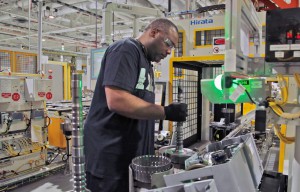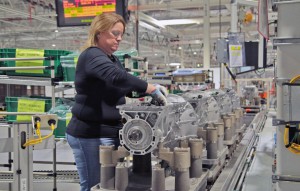
Ford is investing $350 million into its transmission plant in Livonia, Michigan, to add a new fuel-efficient transmission to the line-up.
Despite the growing pressures on the company’s bottom line, Ford is investing $350 million in a transmission plan in Livonia, Michigan, to add a new transmission to expand its line-up of fuel-efficient powertrains as part of the company’s plan to fortify its core automotive business, which is facing tighter fuel-economy standards.
Ford and the United Auto Workers said the investment in Livonia will lead to the retention of 800 hourly jobs to support production of the new transmission. Ford expects to begin adding jobs late this year, with the majority coming next year and in 2019.
“We remain committed to American manufacturing and investing in our people and facilities,” said Joe Hinrichs, newly named executive vice president and president of Global Operations.
“Even as the industry’s largest employer of hourly workers in the United States and biggest producer of American-made vehicles, we believe it is important to continue investing right here in our home market.”
(New Ford CEO Hackett draws comparisons to former CEO Mulally. For the story, Click Here.)
In the past four months, Ford has announced more than $2.25 billion in new investments in Michigan. The company has invested $12 billion in its U.S. plants and created a total of nearly 28,000 U.S. jobs during the last five years.
This investment in Livonia Transmission Plant is in addition to $1.4 billion and 500 created or retained hourly jobs announced for the plant in 2016 to support production of a new 10-speed transmission for the 2017 F-150 Raptor and certain other F-150 trucks.
Ford said the additional investment in Livonia supports production of a new, advanced transmission for front-wheel-drive vehicles. This transmission will provide customers better-performing, more fuel-efficient vehicles. It will share software, design elements and manufacturing processes with the 10-speed and other future transmissions.
(Click Here to see more of the changes to Ford’s management team.)
The new transmission scheduled for production in Livonia will be tuned to blend fun driving and efficiency with Ford engines, including EcoBoost. Most applications will use a common microprocessor with more than 4 million lines of code controlling both engine and transmission.
General Motors and Ford announced nearly five years ago they would collaborate on front-drive and rear-drive automatic transmissions.
Both companies have kept the joint development projects well below the radar and each have said the basic transmission developed through the project would tuned and programmed to fit the characteristics of vehicle lines unique to each company, which have been rivals for more than a century.
(To see more about Ford laying off 1,400 employees, Click Here.)
Ford led development on the 10-speed automatic designed for use in rear-drive applications such as performance and luxury cars, trucks, and SUVs, while GM led on the development of the front-wheel-drive transmission.

